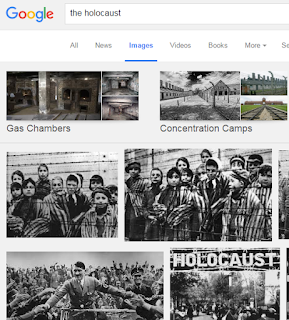Social 10-1
For most of the class we talked about media consolidation and the big 6 media TNCs that produce 90% of the content that you consume. If you missed class today, make sure that you get the "Media Giants and Me" notes from a classmate. Please don't forget that your universalization and hybridization assignment is due on Wednesday, February 21st. Please see the notes below on how to cite the images that you use in your project. Also, don't forget that you have your Chapter 1-2 Test on Thursday, February 22nd, the study guide is posted below.
IMAGE CITATIONS IN APA FORMAT:
STEP 1
Most of you will probably use Google for your image search. Just type in your image search term. I typed in The Holocaust.
STEP 2
A bunch of different images will pop up. Just click on one that you like. I clicked on the first image and a pop-up screen will show you the image more closely.
STEP 3
Click on "View Image". In the address bar you will see a specific URL for the image. This is what you need for your image citation. It should end in either .jpg or .png. or .svg or some other file extension that indicates that it is an image file.
STEP 4
If you're working in Microsoft Word, click on the References tab. You can select the Style of citation here (MLA, Chicago, APA, etc.). If you need to insert an in-text citation, you click on Insert Citation. If you want to start building a Bibliography, you can Insert Citation or Manage Sources.
STEP 5
You'll get a pop-up dialogue box like the one pictured below. I filled in the fields for the image that I picked. There are also online citation machines available as well, such as EasyBib (http://www.easybib.com/)
CHAPTER 1-2 TEST STUDY GUIDE:
- Study your Chapter 1 and 2 Key Terms
- Review the case studies from the textbook in Chapters 1 and 2, specifically the Metis, the Francophones, the Hmong, and the Maori
- Be prepared to answer any of the "Questions for Inquiry" from Chapters 1 and 2 (they are on the following pages: p.9, p.14, p.20, p.29, p.35, p.39):
- How does globalization affect economic aspects of people's lives?
- How does globalization affect social aspects of people's lives?
- How does globalization affect political aspects of people's lives?
- What is the difference between individual and collective identity?
- What is the relationship between identity and language?
- How does cultural exchange shape people's identities?
SOCIAL 20-1
I off the lecture on the Napoleonic Age and showed you a video on Napoleon's invasion of Russia today as well. I will teach you the 19th century political spectrum on Tuesday. Don't forget that you're writing the Chapter 1-2 Test on Wednesday. Please check out the Chapter 1-2 Test Study Guide below.
You should also have a look at this timeline of key events in Napoleon's life that I made a few years ago on Timetoast: http://www.timetoast.com/timelines/3805
You could also check out this one that I made on the key events of the French Revolution: http://www.timetoast.com/timelines/3780
You could also check out this one that I made on the key events of the French Revolution: http://www.timetoast.com/timelines/3780
For both of these timelines, click on the slider button and drag it to advance through the years.
This test will be on Wednesday, February 21st. The test has a matching section and ashort answer section.
Study the following PowerPoint presentations:
CHAPTER 1-2 TEST STUDY GUIDE:
This test will be on Wednesday, February 21st. The test has a matching section and ashort answer section.
- Make sure that you have read both Chapter 1-2 from your textbook Exploring Nationalism
- Study Chapter 1-2 Key Terms from the Unit 1 Worksheet
- Study your answers to the questions from the Unit 1 Worksheet for Chapter 1-2
Study the following PowerPoint presentations:
- "Nation and Identity" (Chapter 1 material + supplementary material)
- "Shaping Nationalism: The French Revolution" (Chapter 2 material + supplementary material; key terms from the French Revolution and Napoleonic Age Glossary of Key Terms)
- "The Napoleonic Age" (Chapter 2 material + supplementary material; key terms from the French Revolution and Napoleonic Age Glossary of Key Terms)
IB 30/35
I showed you a video from the History's Turning Points series on the Korean War. Please check your Google Drive for notes on the Korean War that I shared with you. Please print these notes out, read them, highlight them, and annotate them as well, then add them to your notebooks. I then started talking about the Truman administration. I'll be sharing the Truman administration lecture with you on Google Drive.





No comments:
Post a Comment